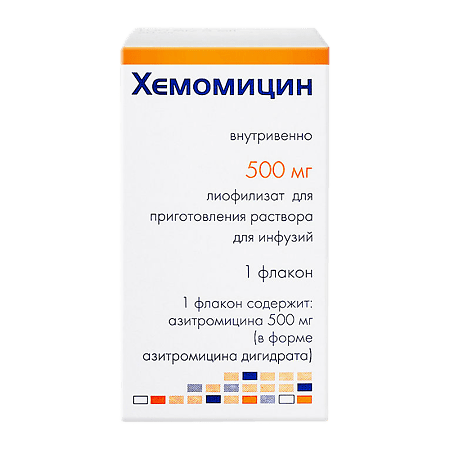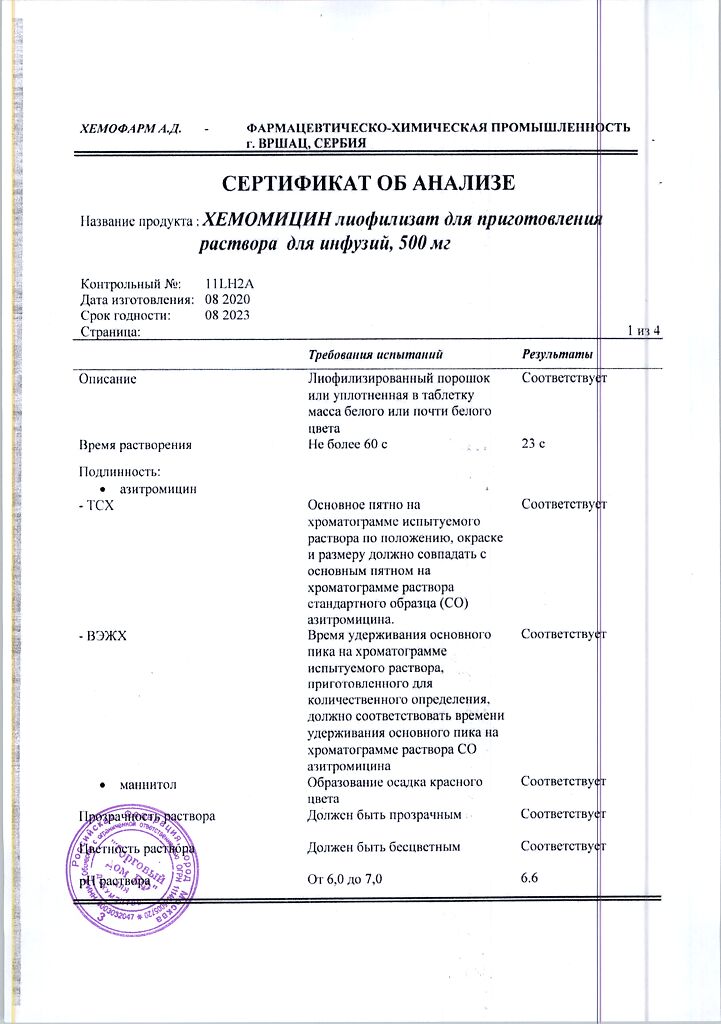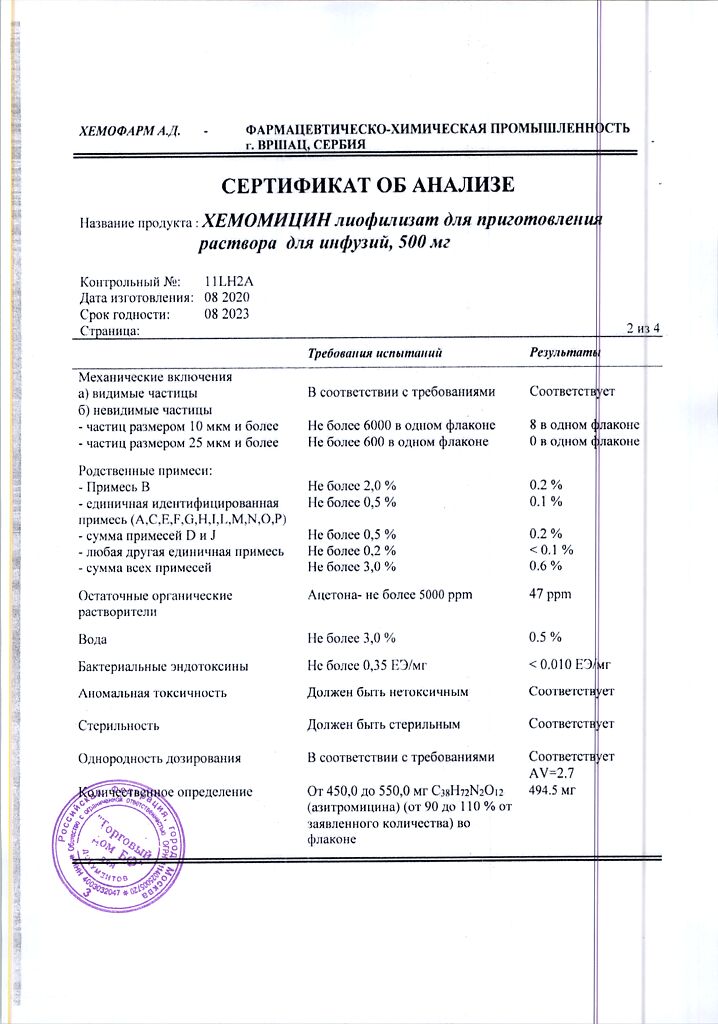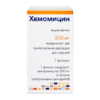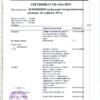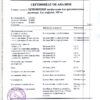No products in the cart.
Chemomycin, lyophilizate 500 mg
€1.00
Out of stock
(E-mail when Stock is available)
Description
Azithromycin is a macrolide antibiotic of the azalide group.
Binding reversibly to 50S-subunit of ribosomes of bacterial cells, it disrupts translocation of the growing polypeptide chain from aminoacyl site to peptide site, which leads to suppression of protein synthesis in bacterial cells.
Sensitive:
aerobic gram-positive microorganisms – Staphylococcus aureus (methicillin-sensitive), Streptococcus pneumoniae (penicillin-sensitive), Streptococcus pyogenes;
aerobic gram-negative microorganisms – Haemophilus influenzae, Haemophilus parainfluenzae, Legionella pneumophila, Moraxella catarrhalis, Pasteurella multocida, Neisseria gonorrhoeae;
anaerobic microorganisms – Clostridium perfringens, Fusobacterium spp., Prevotella spp., Porphyromonas spp.; others – Chlamydia trachomatis, Chlamydia pneumoniae, Chlamydia psittaci, Mycoplasma pneumoniae, Mycoplasma hominis, Borrelia burgdorferi.
Moderately sensitive:
Streptococcus pneumoniae (moderately sensitive or penicillin-resistant).
Resistant:
aerobic gram-positive microorganisms – Enterococcus faecalis, beta-haemolytic Streptococcus spp. group A, Staphylococcus spp. (methicillin-resistant), including Staphylococcus aureus, resistant to erythromycin and other macrolides, lincosamides; anaerobes: Bacteroides fragilis.
Indications
Indications
Active ingredient
Active ingredient
Composition
Composition
1 vial azithromycin dihydrate 524 mg, which corresponds to the content of azithromycin 500 mg
Excipients:
Citric acid monohydrate – 110 mg,
Mannitol – 146 mg,
Sodium hydroxide – q.s.
How to take, the dosage
How to take, the dosage
The drug should only be used in a hospital setting!
The recommended doses for intravenous administration of azithromycin in the treatment of adults and patients over 18 years of age for the following conditions:
Community-acquired pneumonia (CAP)
500 mg once daily intravenously (IV) for at least 2 days (if necessary, at the decision of the attending physician, the IV course may be extended, but should not be more than 5 days).
The intravenous infusion should be followed by a subsequent oral administration of azithromycin as a single daily dose of 500 mg until completion of a 7-10 day total course of treatment.
Infectious inflammatory diseases of the pelvic organs
500 mg once daily intravenously for at least 2 days (intravenous course of treatment is no more than 5 days).
The intravenous infusion should be followed by a subsequent oral administration of azithromycin as a single daily dose of 250 mg until completion of the 7-day total course of treatment.
The timing of the switch to oral treatment is determined according to clinical findings.
Patients with impaired renal function
When used in patients with mild to moderate renal impairment (creatinine clearance > 40 ml/min), no dose adjustment is required.
Patients with hepatic impairment
Dose adjustment is not required in patients with mild to moderate hepatic impairment.
Elderly patients
Dose adjustment is not required in elderly patients.
The solution for infusion is prepared in 2 steps:
Phase 1 is the preparation of the reconstituted solution:
In a bottle containing 500 mg of the drug, 4.8 ml of sterile water for injection is added and shaken thoroughly until the powder is completely dissolved.
The resulting solution contains 100 mg of azithromycin in 1 ml.
The prepared solution is stable for 24 hours at room temperature.
Step 2 dilution of the reconstituted solution (100 mg/ml) is carried out immediately prior to administration according to the table below.
The concentration of azithromycin in the infusion solution
Amount of solvent
1.0 mg/mL
500 ml
2.0 mg/mL
250 mL
. The reconstituted solution is added to a bottle with solvent (0.9% sodium chloride solution, 5% dextrose, Ringer’s solution) until the final concentration of azithromycin 1.0-2.0 mg/mL in the infusion solution is obtained.
Chemomycin solution should not be administered intravenously by jetting or intramuscularly!
It is recommended that the prepared solution be administered intravenously by IV drip for 3 hours – 1 mg/ml infusion solution, for 1 hour – 2 mg/ml.
Before administration the solution is subjected to visual control. If the prepared solution contains particles of the substance, it should not be used.
The prepared solution is stable at room temperature for 24 hours.
Interaction
Interaction
Azithromycin has no effect on the blood concentrations of carbamazepine, cimetidine, didanosine, efavirenz, fluconazole, indinavir, midazolam, theophylline, triazolam, trimethoprim/sulfamethoxazole, rifabutin and methylprednisolone when used together.
If co-administration with cyclosporine is necessary, it is recommended to monitor the blood levels of cyclosporine.
When digoxin and azithromycin are coadministered, blood digoxin concentrations should be monitored because many macrolides increase digoxin absorption in the intestine, thereby increasing its plasma concentrations.
When co-administration with indirect anticoagulants (warfarin, other coumarin-type anticoagulants) it is recommended that patients should have careful control of prothrombin time.
The concomitant use of terfenadine and macrolide class antibiotics causes arrhythmias and prolongation of QT interval. This data should be considered when using terfenadine and azithromycin concomitantly.
In co-administration with nelfinavir there may be an increased incidence of azithromycin side effects.
Possible inhibition of CYP3A4 isoenzyme by azithromycin in co-administration with cyclosporine, terfenadine, ergot alkaloids, cisapride, pimozide, quinidine, astemizole and other drugs metabolized with this enzyme should be considered.
When azithromycin and zidovudine are used together, azithromycin has no effect on the pharmacokinetic parameters of zidovudine in blood plasma or on the renal excretion of it and its metabolite glucuronide.
Yet, the concentration of the active metabolite, phosphorylated zidovudine, in mononuclear cells of peripheral vessels is increased. The clinical significance of this fact has not yet been determined.
In co-administration of azithromycin with ergotamine and dihydroergotamine their toxic effects (vasospasm, dysesthesia) may occur.
Pharmaceutically incompatible with heparin.
Special Instructions
Special Instructions
The safety and efficacy of the injectable form of Chemomycin in children under 16 years of age has not been established.
The drug should not be administered for longer courses than indicated, since the pharmacokinetic properties of azithromycin allow for a short dosing regimen.
Possible superinfections (including fungal) when treated with Chemomycin (as with any antibiotic therapy).
Diarrhea/pseudomembranous colitis caused by Clostridium difficile may develop when using Chemomycin. Because of this, patients with diarrhea should be monitored closely.
After treatment withdrawal, hypersensitivity reactions may persist in some patients, requiring specific therapy under medical supervision.
Impact on the ability to drive and operate machinery
Because of the possibility of side effects from the CNS, caution should be exercised when driving vehicles and operating machinery.
Contraindications
Contraindications
Side effects
Side effects
CNS disorders: dizziness/vertigo, headache, drowsiness seizures; paresthesias, asthenia, insomnia, increased excitability, fainting, aggressiveness, restlessness, nervousness.
Sensory organs: tinnitus, reversible hearing impairment to deafness (when taking high doses for a long time), visual impairment, disorders of perception of taste and smell.
Cardiovascular system: palpitations, arrhythmias including ventricular tachycardia, prolonged QT interval, bidirectional ventricular tachycardia, decreased BP.
Digestive system disorders: Nausea, vomiting, diarrhea, abdominal pain and lumps, liquid stools, flatulence, digestive distress, cholestatic jaundice, hepatitis, gastritis, changes in laboratory
Liver function parameters, constipation, discoloration of tongue, pseudomembranous colitis, pancreatitis, liver necrosis, liver failure (possibly with fatal outcome).
Blood and lymphatic system disorders: thrombocytopenia, neutropenia, leukopenia, neutrophilia.
Allergic reactions: itching, skin rash, angioedema, urticaria, photosensitization, anaphylactic reaction, including edema (in rare cases with fatal outcome), erythema multiforme, Stevens-Johnson syndrome, toxic epidermal necrolysis.
Muscular system disorders: arthralgia.
Urinary system disorders: nephritis, acute renal failure.
Local reactions: pain and inflammation at the site of administration.
Others: candidiasis, including oral cavity and genital, fatigue, malaise, anorexia, vaginitis.
Overdose
Overdose
Symptoms: severe nausea, temporary hearing loss, vomiting, diarrhea, abdominal pain, liver dysfunction.
Treatment: symptomatic.
Similarities
Similarities
Additional information
| Weight | 0.020 kg |
|---|---|
| Conditions of storage | In a place protected from light, at a temperature not exceeding 20 °C. |
| Manufacturer | Chemopharm A.D., Serbia |
| Medication form | lyophilizate |
| Brand | Chemopharm A.D. |
Other forms…
Related products
Buy Chemomycin, lyophilizate 500 mg with delivery to USA, UK, Europe and over 120 other countries.

